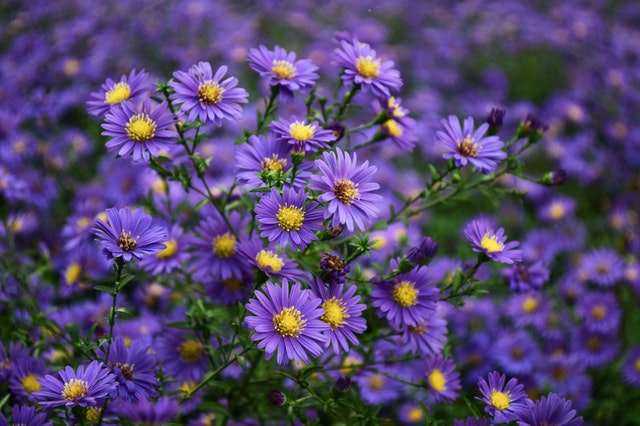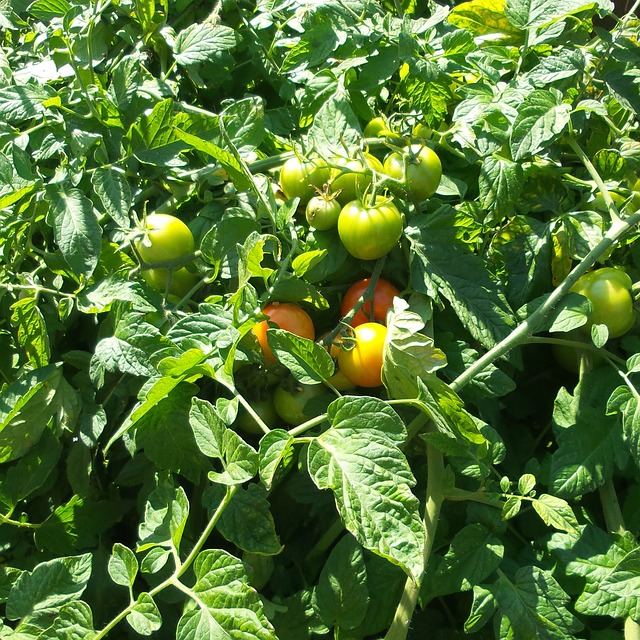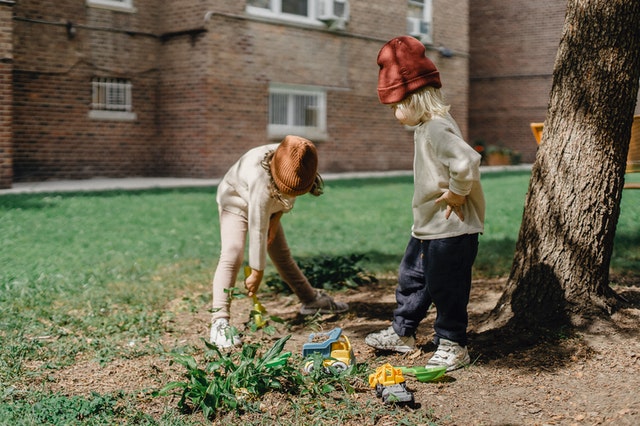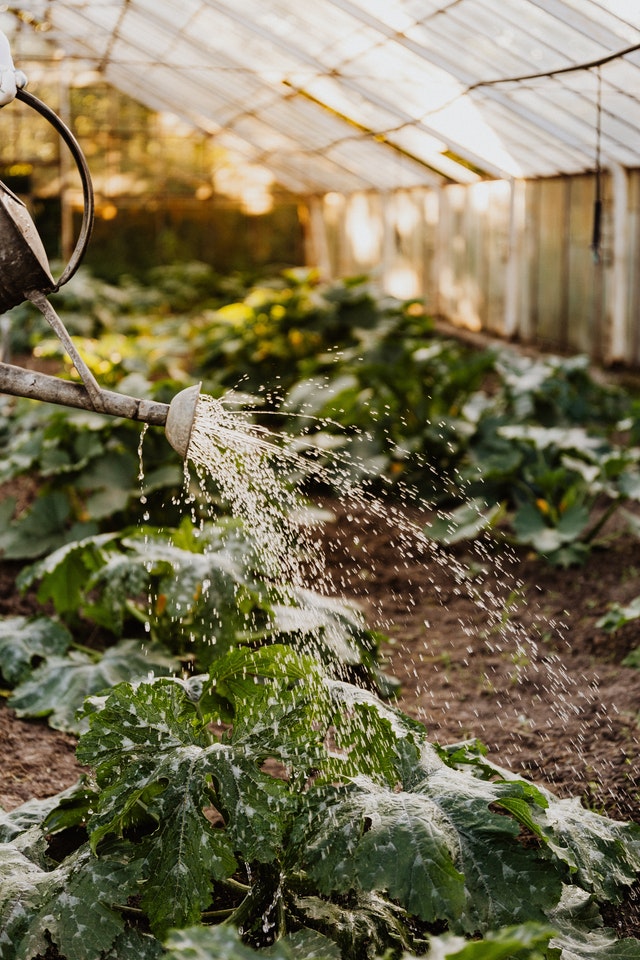Incorporating Vegetables into a Landscape Design
This is an excerpt from the Book called “Edible Landscaping“ by Rosalind Creasy . Continue reading to learn more about Incorporating Vegetables into a Landscape Design , thanks to the author.
Historically, mainstream designers, who design primarily for industrial and estate gardens, seldom considered incorporating perennial vegetables such as asparagus, artichoke, cardoon, horseradish, Jerusalem artichoke, and rhubarb—by far the most popular attractive perennial vegetables, though there are also less common ones like chayote and oca—despite the fact that all would add visual interest to any garden. Today that is changing.
Those same designers seldom considered annual flowers—much less vegetables, most of which are annuals—as true landscaping plants, and short of adding a bed or two of these blooms, didn’t factor annuals of any kind into a garden scheme. Yet the under-recognized and undervalued importance of all annuals is their impermanence and wide emotional appeal. Add them as splashes of color—accents you can change whenever you want. The ritual of planting annuals is one of the best ways I stay connected to my garden and its soil.
Perennials
Since perennial edibles require a permanent space in the garden, you should start with them.
Asparagus is the most popular, and because it has unique cultural needs, it is usually grown in its own bed. If you’ve seen asparagus only in the supermarket, you might not have a clue about how it grows. In spring, the asparagus stalks rise up out of the ground. Cut individual spears off at ground level as you need them for about 6 weeks. At that point, allow emerging stalks to grow up and leaf out, renewing the plant for next year’s harvest. The 4-foot-tall, fernlike plants remain attractive for the rest of the growing season. In autumn, the fronds turn a rich yellow, adding an unexpected dash of seasonal color. During one of my visits to Longwood Gardens in Pennsylvania,
I photographed a 3-foot-deep bed of asparagus beautifully screening the compost area from the vegetable garden. Tall yellow marigolds grew in front of the asparagus; the flowers stood out brilliantly against the dense green background.
The large silvery foliage of artichoke and cardoon is magnificent in a landscape. Both plants make dramatic statements in any perennial border. In Zones 7 to 9, where artichoke is hardy, the leaves tend to die back to the ground in midsummer. My favourite way to mask that empty space is to plant tall cosmos in early summer; after the harvest, when the leaves start to die back and you cut them down, the cosmos is already a foot or so tall. Once there is no competition for light, the cosmos shoots up to its full height within a few weeks. In several months, when new artichoke leaves emerge and begin to grow, it’s time to tear out the cosmos. Often yellow finches help themselves to the cosmos seeds, encouraging the plants to reseed themselves.

Although rhubarb’s harvest season may be short, its bold presence persists until frost. It is a traditional kitchen garden plant; no doubt your grandmother grew it near her back porch. In arid climates, where rhubarb gets spider mites that disfigure the foliage, it is probably best planted in the “back 40,” but healthy bright red stems and dramatic large leaves are striking on either side of a path or in mid-border. Plant it where you can sit with a cup of tea and watch the late afternoon sunlight transform the red stems into stained glass. Show it off in a border with daylilies running alongside the garage or combine rhubarb with ruby chard, red landscape roses, or red geraniums in a patio bed.
Horseradish and Jerusalem artichoke are in a category by themselves as they are invasive. Keep both within bounds by planting them in bottomless trash cans so the roots are contained and will not spread. Horseradish has slightly undulating basal leaves that grow to 36 inches long; a dramatic variegated horse-radish with green and white leaves is smaller and easier to keep in bounds, though it often reverts to green. When not eaten by flea beetles, horseradish adds substance when growing alongside smaller-leaved plants like black-eyed Susan and purple coneflower. Jerusalem artichoke, with its small, sunflower-like blossoms, grows 8 to 10 feet tall, so set it at the back of a border and provide support or else it will flop. It is a splendid companion for large grasses, canna, and joe-pye weed. A bonus: Jerusalem artichoke is a magnet for beneficial insects and birds.
Annuals
To me, annual vegetables are like garden eye candy, from the brightly colored stems of ‘Rainbow’ chard to ‘Australian Yellow’ lettuce and variegated ‘Fish Pepper’ chilli pepper. All are spectacular additions to the decorative garden.
Whimsy, a bit of surprise, and delight—annual vegetables can add joy to any ordinary ornamental landscape. When visiting Denver Botanic Gardens, I was tickled to see big orange pumpkins hanging down from a large white arbour. As I stood there taking photographs, I turned and saw children pointing with glee at the pumpkins growing in such a delightful way.
One recent spring, I grew a bed of tulips under-planted with a mesclun salad mix. It was such a success that I now underplant fall bulbs with all sorts of salad greens. I’ve also grown edible table arrangements—low containers filled with herbs or greens to put on the table instead of a flower arrangement. My favourite was Bibb lettuces planted in a geometric design in a shallow square terra-cotta container; it was a showstopper. On another occasion I planted purple baby pac choi with white violas in the corners of the same square for another eye-catching centrepiece. Needless to say, the container lived outside and was only brought to grace the table for special guests.
Specialty Vegetable Gardens
In 1984 I took out our front lawn and started using the area as my trial garden. Since then, with the help of a succession of gardeners, I’ve changed my front garden and planted all sorts of new edibles twice a year—that adds up to nearly 50 trial gardens. Having read Barbara Dam-rosch’s book Theme Gardening, first published in 1982, I thought it seemed like a fascinating way to organize a garden space. I found that, given the thousands of vegetables and herbs I could grow every season, making each one a specialty garden with a theme helped limit my choices each season. For instance, in 1992—the 500th anniversary of Columbus’s landing in the New World—I planted a garden full of indigenous plants, including the “three sisters” (beans, corn, and squash, a trio of companionable plants that Native Americans traditionally grew together), tomatoes, chilli peppers, sunflowers, and amaranths.
I’ve grown scored of children’s gardens; you’ll see photos in this and other chapters. Over the years, I must have planted and cooked produce from at least a dozen distinct specialty salad gardens—some in containers, many combined with edible flowers. I’ve grown an Italian wild greens garden, a salsa garden, and a rainbow garden that featured everything from blue potatoes and rainbow-colored chard to red carrots and purple artichokes. As it turns out, it was great fun to choose different subjects and to do all the research; these specialty gardens have been a great tool to help limit my choices and to learn more with every vegetable garden I grew.
The following are a few of the almost limitless types of specialty or theme gardens to get you thinking about what type of vegetable garden you want to grow.
Ethnic Gardens
Until the 1970s, the American palate and cooking repertoire were fairly narrow; the preferences that dominated and limited our cuisine were for soft foods—salty or sweet—nothing bitter, and heaven forbid, nothing spicy or too chewy. Salads were formulaic, certainly no fruit, baby greens, and balsamic vinegar in view. Most vegetables were boiled or sautéed; potatoes were baked or boiled, rarely roasted, much less with olive oil and rosemary.
Yet change has come; we’re slowly expanding our palate. From Mexican cuisine, we’re learning about chillies and toasting vegetables to intensify flavours, and spicy salsa has now overtaken ketchup as the most popular condiment in America. European salads are multidimensional with their peppery arugula, bitter radicchio, and sour sorrel. From China we’re gaining an appreciation of stir-fried, slightly crisp vegetables—even greens.
As an edible gardener, you have the opportunity to explore ethnic cuisines not available to even the most sophisticated chefs unless they have gardens; growing vegetables gives you the widest possible choices. One packet of seeds costs less than a pound of most specialty food and provides flavour some fare for multiple seasons. To get started growing ethnic vegetable gardens, see the descriptions for the seed companies listed in sources and Resources.

Grain Gardens
It’s hard to convey the feeling, but the hair stood up on the back of my neck as I prepared to harvest my first crop of wheat. My friends and I—hedge shears in hand—stood in front of these primordial golden stalks, cut the heads off, and then tossed them onto and old sheet. Why, I asked myself, had never done this before? Probably because I thought I needed a section of prairie and a McCormick reaper to make wheat growing worthwhile.
That was nearly 25 years ago, when I was searching for an uncommon edible to expand the American gardener’s image of an edible garden, especially the vegetable garden. As it turns out, there is no set definition of a vegetable, so I decided to stretch the concept as far as I could. As I looked through the Bountiful Gardens catalog, I noticed all the different grain seeds and was inspired. What a fun project it would be to grow my own wheat and then grind it to bake bread! I called John Jevons (co-owner of Bountiful) to ask if it would be worthwhile to grow an enough to make 20 loaves of bread. And that’s how my adventure with grains started.
In the ensuing decades, I have grown hull-less oats and flax seed and gloried in a score of wheat harvests. Our harvesting method is a melange of John’s recommendations and my neighbour’s and my experiences over the years. Traditionally, our 4th of July begins early in the morning, when neighbours, friends, and family come here to join in the wheat harvest. Adults and children alike head into the garden, cut off the wheat heads, and nowadays toss the heads into a garden cart so they are easier to carry to the driveway, where we empty them onto an old sheet (a hard surface like a driveway is essential). Then we cover our harvest with another sheet and pour wheat berries back into the cart. I’ve found that an electric lead blower is just dandy for gently blowing away the chaff. We grind up enough wheat berries to make two loaves of bread, which the children ceremoniously offer to the neighbours at the annual block party later in the day.
Wheat is one of the easiest edible crops to grow. It needs little fertilizing and has few pests and diseases. Try growing other grains, too-barley, oats, rye, and even rice (no, you don’t need a paddy). Refer to the “wheat” entry in the Encyclopaedia for detailed information on growing wheat and Appendix A for information on growing wheat and Appendix A for information on other basic grains.
Heirloom Gardens
While there is no official definition, an heirloom vegetable is considered to be any open-pollinated variety (not a hybrid) that has been in cultivation for at least 50 years. Since the middle of the twentieth century, seed companies have offered mostly hybrid vegetable varieties, which meant that gardeners could not save the seeds, as they don’t grow true to type. Consequently, thousands of open-pollinated varieties, many beloved by generations of home gardeners, were lost. This was not just a problem in the United States. According to the United Nations Food and Agriculture Organization, in the past century three-quarters of biodiversity in crops has been lost. Fortunately, in the 1970s, many gardeners became aware of this loss of genetic diversity, started saving their old varieties, and are now dedicated to preserving many of them.
Over the years I’ve attended conferences at Seed Savers Exchange, visited heirloom trial gardens and home hobby gardens filled with old-time varieties, and met many fascinating people. Amy gold man, author of three books on heirloom vegetables (The Heirloom Tomato, Melons for the Passionate Grower, and the Com-pleat Squash), gardens in New York’s Hudson River Valley. Amy grows hundreds of heirlooms both to preserve their DNA and document their individual characteristics. I may never forgive her for serving me a luscious heirloom melon at its peak of ripeness—wrapped in a cloud of perfumed fragrance, seductively smooth as it wrapped around my tongue, honey sweet, and down-right sensual-bedecked with a scoop of homemade vanilla ice cream. Since then, every time I’ve had a slice of melon I compare it with that perfect melon. Unless you grow melons yourself, you are limited to commercial varieties—sorry substitutes for the real thing. Store bought melons have a cardboard texture, a light sweetness, and only a hint of melon flavour. I have grown melons on numerous occasions—mostly modern varieties—but only a few California summers were warm enough to produce a great melon, and none had the depth of flavour that Amy’s had.
Many books on vegetables include melons, despite the fact that we eat them like fruit—as a dessert. Technically speaking, however, both squash and tomatoes fall under the botanic appellation of fruit (as do melons). Here are some of Amy’s favourite heirloom tomatoes (all her favorite are indeterminate except as noted), squash, and melons:
Burpee’s Globe’ tomato—a perfect pink globe, honey sweet; introduced by Burpee in 1935.
‘German Pink’ tomato—a luscious, meaty, pink beefsteak tomato; historic as it was one of two varieties given to Kent and Diane Whealy, which inspired them to found Seed Savers Exchange; brought from Bavaria by Diane’s great-grandfather, Michael Ott, in 1883.
‘Green Giant’ tomato—large green beefsteak; sweet, juicy; potato-leaved type.
‘Marina di Chioggia’ winter squash—amazingly warty green squash; long enjoyed in Italy for its delicious flavour; born to be gnocchi and ravioli.
‘petit Gris de Rennes’ French cantaloupe—dates back nearly 400 years; small, green and brown speckled; intensely sweet orange flesh and a melting texture.
‘Red Brandywine’ tomato—Amy’s research unequivocally confirms that the original ‘Brandy-wine’, as introduced by Johnson and Stokes in 1889, was red and had standard tomato leaves; she describes it as one of the best-tasting tomatoes.
‘San Marzano’ tomato—Italian red plum, determinate, great taste in the right climate; Amy’s research shows that this tomato revolutionized the tomato-canning industry in the 1920s.

‘Winter Luxury Pie’ pumpkin—introduced in 1893; small elegant pumpkin with fine lacy markings; makes the smoothest, most velvety pumpkin pie ever.
There are many variations on heirloom gardening. Some gardeners, like Amy, specialize; she’s partial to tomatoes and spruce up the plot with heirloom flowers like hollyhocks, kiss-me-over-the-garden-gate, and love-lies-bleeding. Still other heirloom gardeners enjoy recreating a garden their grandparents grew or growing old-time oddities like top-setting sand knob onions, huge ‘Cow Horn’ okra, and purple orach.
Valuable books foe seed savers are Heirloom Vegetable Gardening by William Woys Weaver and Seed to Seed by Suzanne Ashworth, which is filled with seed-saving techniques for individual species. Visit heirloom vegetable websites and choose heirlooms that catch your fancy. Help keep these precious gene pools live. Seed Savers Exchange in Decorah, Iowa, has the most comprehensive information on heirlooms; go to www.seedsavers.org.
Children’s Gardens
When I speak about children’s gardens, my presentations are full of fun projects-with the underlying message I learned years ago from Alice Skelsey and Gloria Huckaby’s book Growing Up Green: “Gardening is caught- not taught.” An elderly woman came up to me in tears after I finished my talk at the Garden Symposium at Colonial Williamsburg. “You answered why my grandchildren don’t want to garden with me,” she said. “I wanted them to learn to garden, so first I made them weed an area, they planted it, and I guess I nagged them to keep it up. So now they won’t join me in the garden.”
I hadn’t realized how lucky I was when I started gardening with my dad. We had the joy of watching seedlings emerge, and together we searched for cutworms that ate some of the young plants. Every time I found one, he cheered. I was the hero in our garden story. When I was five years old he deeded me my own vegetable garden-a little plot adjacent to his big garden-with no rules. The only thing I ever harvested from the little plot was a deep love of gardening and the outdoors.
When I first moved my edible garden to the front yard in 1984, I didn’t invite any of the neighbourhood children in. I was afraid they would damage plants or pick flowers and vegetables. At the end of the third summer, I figure that since we were going to pull out the whole garden and put in a new one for winter, why not let some of the kids pull carrots that were ready to harvest and pick flowers. And pick them they did-for over an hour. They arranged the hundreds of flowers on the lawn next door, took the loot home, and put flower arrangements all over their houses. They christened it “The flower Fling,” and my life was never the same| Bless their hearts, they taught me to take the brakes off and enjoy the garden with all my might.
The kids were such a joy that I invited them more often. First we developed some basic ground rules:
Don’t come over without an invitation. Always ask your parent’s permission. And there are people places and plant places—the paths are for people and the beds are for plants. Soon I was photographing them planting peas, pulling carrots, and harvesting strawberries. Once I planned for the kids to plant sunflowers, but they decided that a “let’s use Ros’s hand lens and go look for spiders” session would be much more fun. Fortunately, I had learned not to have an agenda set in stone.
In the past 20 years I’ve grown lots of theme gardens for”my kids,” including an Alice in Wonderland garden with a teahouse and bean and cherry tomato maze. I’ve grown plots of wheat and peanuts for them to plant and harvest, made pumpkin patches, and grown rows of strawberries for them to enjoy without asking. I’ve come full circle, and I see the time I spend with the kids in my garden as a priceless gift. Now my grandson Alex, who visits from time to time, has helped harvest wheat and plant a corn patch.
Enjoy your garden with children and pass the gift on. Here are a few ways to get started:
- Grow sprouts on your kitchen counter. Children have a short attention span, and many sprouts are ready to eay in less than a week. Go online for a quick introduction to sprouting.

- Plant a wine barrel with seed potatoes; layer the top foot or so with straw to make it easy to harvest the spuds.
- A bean tepee is always a winner. In addition to the fun of picking beans, kids have a great summer playhouse. Plant the beans on the outside of the poles or the plants will likely get walked on; line the floor with lots of straw to keep it from getting “icky”.
- Grow pumpkins. When they are fully grown but not yet ripe (the skin still fairly soft), let the children write their initials on the of their pumpkin with a ballpoint pen. As the pumpkins ripen, the letters become brown and hard, standing out against the orange skin. Children can have their own personalized Halloween pumpkin.
- Get a large hand lens and go hunting in the garden for creepy crawlies.
- Put in a small chicken coop; nothing delights children more than feeding chickens and gathering eggs. My neighbourhood kids do it enthusiastically, day after day. And the chickens cheerfully recycle the sunburned tomatoes and spent bean vines, which eventually end up fertilizing the beds.
- Plant an arbor with several colors of cherry tomatoes. Let children pick and eat the fruits to their heart’s content.
As you can see, there are endless variations on a garden full of vegetables. For more information and inspiration for designing with vegetables, seek out The Ornamental Vegetable Garden by Diana Anthony, Beautiful American Vegetable Gardens by Mary Tonetti Dorra, and Creative Vegetable Gardening by Joy Larkcom.
Return to homepage “Bloom Tree Trimming Service“

